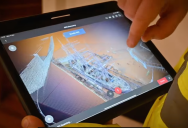A Digital Replica Of Shackleton’s Antarctica-Exploring Ship Is Now Available Online

Back in 1901, explorers Robert Falcon Scott and Ernest Shackleton took a ship to explore Antarctica.
It was a groundbreaking mission that changed the face of the world.
Now, you can take a digital tour of their ship online.
The RRS Discovery was built in Dundee, Scotland, and set sail south to Antarctica 123 years ago. The ship was designed specifically to carry out scientific research in the harsh environment at the South Pole.
The designers used all of the information they had from the previous expedition in 1839 to outfit it, and the team was able to carry out scientific and geographical research into the (at the time) mysterious continent.
They inspired subsequent voyages to the Antarctic during the end of the 19th century-early 20th century that saw discoveries like the Cape Crozier emperor penguin colony and several previously unknown marine species.
The RRS Discovery herself returned to the Antarctic in 1925 and 1929, returning to Dundee for the last time in 1986 to become a multi-award-winning visitor attraction.
Every year, over 80,000 visitors come to check out this particular bit of history.
Now, researchers at the University of Southampton have created a highly accurate 3D representation – a “digital twin” that provides insights into how the ship was built, as well as ongoing restoration work on the original vessel.
Dr. Michael Grant issued a statement about the accomplishment.
“This digital twin provides an amazing opportunity for more people to explore this fascinating ship and learn about its history in a completely new way – including areas of the ship that cannot be accessed by the public.”
He believes this can help people understand more about what it was like back then.
“Through this we can obtain even greater insights into the lives of the people who explored the Antarctic over a century ago, providing the foundation for much of the ocean and climate science being undertaken today.”
They created the digital twin by using unmanned aerial vehicles (UAVs) and laser scanners to make digital recordings of the vessel. They allowed the team to capture the ship’s precise shape, dimensions, and details
They used LiDAR, a technique for remote sensing that uses light in the form of a pulsed laser, to create a highly accurate 3D representation of the whole ship, inside and out.
Dr. Felix Pedrotti explained where they went from there.
“With the rise of new technologies, such as laser scanners and UAVs, we can now create highly accurate digital twins. These digital replicas offer invaluable insights into the RRS Discovery, including its structures and layouts.”
In 2023, the RRS Discovery celebrated 100 years of service, and Dr. Tammy Horton, manager of the Discovery Collections at the National Oceanography Centre, Southampton thinks that’s worthy of celebration.
“This digital model marks the beginning of an exciting project to bring together the stories of the RRS Discovery, which will ensure all the artefacts and findings of those early expeditions are available to all, enhancing our understanding of the work undertaken by the ship then and how this research continues today.”
This seems like a cool opportunity that would be available to anyone around the world.
A little bit of history right in your home!
If you thought that was interesting, you might like to read about the mysterious “pyramids” discovered in Antarctica. What are they?

Sign up to get our BEST stories of the week straight to your inbox.




